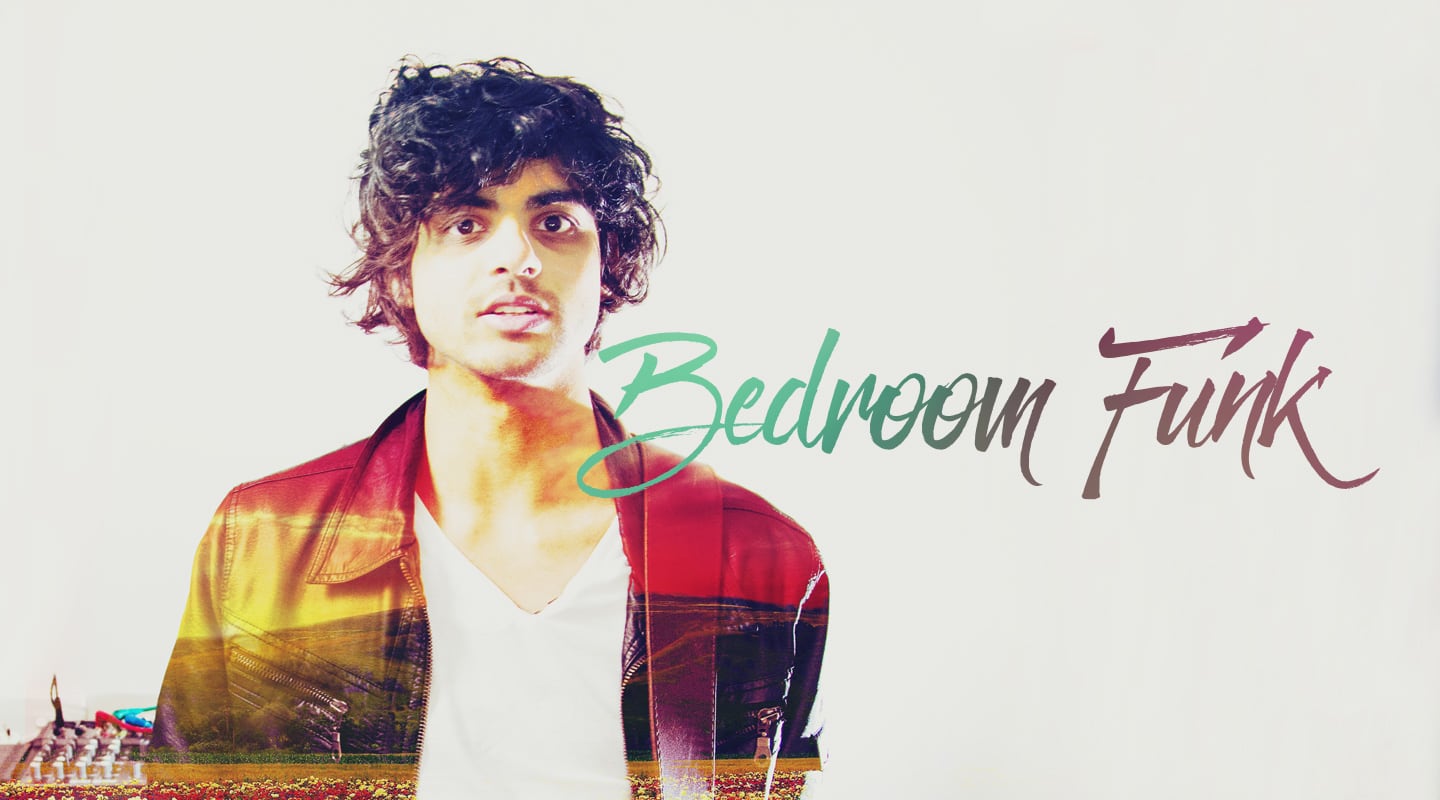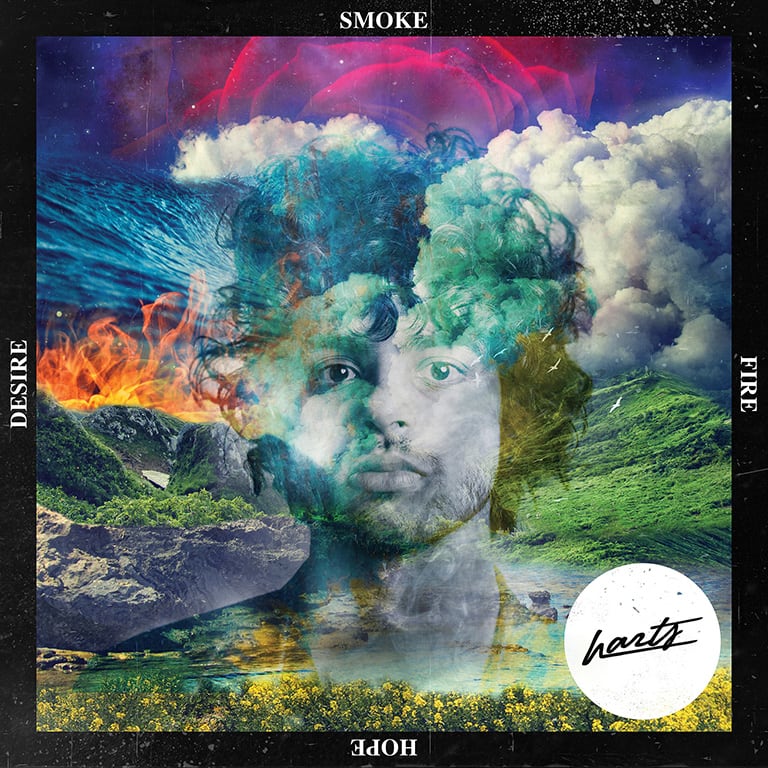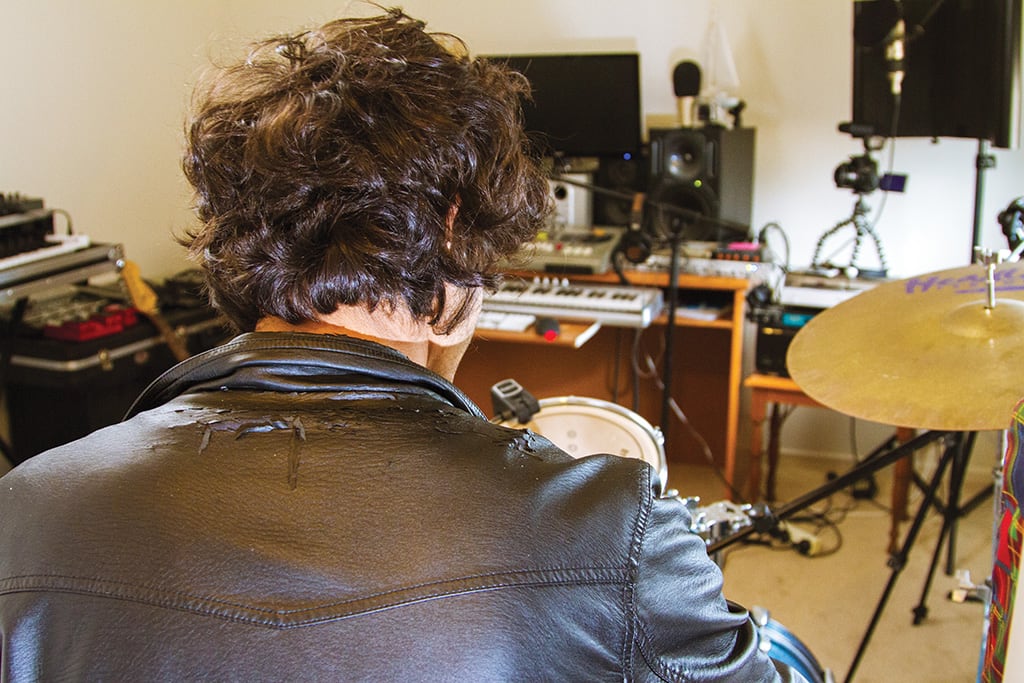
Bedroom Funk
Harts is like a funky version of Kevin Parker, smashing out blazing modern soul and funk rock from his budget collection of gear in his bedroom studio.

Artist: Harts
Album: Smoke Fire Hope Desire
It hasn’t been the smoothest ride for independent artist Darren Hart, aka Harts, but occasionally enduring a stop start journey and going round in circles has had its up-sides. Harts has always been a prodigy, regardless of the field. Early on, it was the athletics oval, where he trained every sinew to deliver him down the stretch. These days he channels that fine muscle control to his extremities, laying down impressive finger work on his psychedelically-painted Squier Strat. He doesn’t need no vintage American-made guitar to rock.
That guitar work, and the songs he writes, captured the attention of none other than the late Prince — his ringing endorsement was saying Harts reminded him of a younger version of himself — and The Roots’ Questlove, who commissioned him to be the Australian representative for a Lenny Kravitz-helmed remake of their song The Fire for the Rio Olympics. His axemanship even landed him in the backseat of a modified Subaru WRX playing his guitar while the driver revved the wah wah throttle pedal. Not the most comfortable ride, but they got it to work, and it worked for Harts.
DEAL DONE RIGHT
All that attention — from the Paisley Park visits, to the car ads — was doing Harts’ negotiating position big favours when he went shopping for a record deal. Back in 2011, he was signed to Universal Music for his first EP, five years later, he came full circle to sign a licensing deal with Dew Process, a label under Universal’s banner. He’d been negotiating for about a year with the label while those endorsements were filing in; his festival sets were getting later in the evening as punters cottoned onto his good-time soul/funk stage show; headline sets sold out and moved to bigger venues; and Triple J more eagerly put him on rotation — to the point where his latest album, Smoke Fire Hope Desire, was a Triple J feature album.
He learnt a lot about record deals from that first direct signing, and was adamant he wanted to stay fiercely independent. His new deal means he still owns all his master recordings, through his own label Offtime Music, licensed to Dew Process. He gets to decide when his releases come out, taking on the advice and experience of the label and his long-time manager. “ I’d always wanted to work with a label,” he said, “but I also wanted to be able to call the shots about when things went out.” Though, now he’s got control, he’s on the other side of the table, stressing about whether he’s rushing the schedule rather than being frustrated by delayed release plans.
Harts is happy with his new deal, which is reflective of the way he makes music — fully in control of the process from start to finish. His recently released full-length, Smoke Fire Hope Desire was made much the same way his album and EP were done before that; in his bedroom, with a modicum of gear.
He didn’t plan to keep the same recording and mixing process, but during the year he was floating between US label meetings, all they wanted to hear was new material. “I started writing and recording around CMJ, but for no real purpose,” recalled Harts. “The Breakthrough EP cycle had just finished, and I could either take a break and do nothing, or try get a single back on radio right then.” He pitched a few things and Peculiar made its way onto Triple J and a few US stations, which got him thinking about putting together another album. “I wasn’t really thinking about a new way of recording,” he said, “because I was just doing it and naturally fell into the way I’d been recording in here.”

BEDROOM ON A BUDGET
The small barely treated room in Melbourne where Harts makes his music has a Logic workstation on an iMac and a pair of Behringer Truth monitors sitting alongside some Polk hi-fi bookshelf speakers. He uses a couple of multi-track recorders — including a Yamaha AW1600 and a Boss BR-600 — for specific channel strip settings on the way into his M-Audio Fast Track Ultra 8R interface. His vocal mic is a Behringer B1 large diaphragm condenser. It’s a very budget setup. That’s the way Harts operates. Like his Squier Strat shows, he’s not fixated on ‘must-have’ Neves and vintage compressors, he’s focused on what sounds he can manipulate out of the gear he already owns.
He also uses samples to augment whatever he can’t record adequately in his bedroom. A technique he learnt out of necessity, but developed into an aesthetic early on in his career. “I used to do dance work for Ministry of Sound when I was coming up,” he explained. “I learnt all about sweeps and drops and how to build dynamics in that style of music. It’s great for my music, because if I did the straight revivalist thing, it would be like a lame version of Jimi Hendrix.”
He skewers any chance of that label right at the beginning of the album. The down-tempo opening to Smoke is distantly vintage and swathed with tape modulations. The laid-back swung groove and vocal-mimicking guitar lines sounds like Hendrix riffing in a moment of downtime while the tape operator finds the sweet spot. The vintage revivalist facade quickly fades out to make way for Harts as a real funk force, and he doesn’t let up from there.
Harts’ sample techniques and the moves he picked up on the dance floor show themselves right away with his drums sounds. He currently has a Questlove breakbeat kit made by Ludwig, but it really doesn’t matter what drum kit he uses. He places Roland triggers on the kick and toms, and airballs the cymbals during tracking so he can play them in with a MIDI keyboard after the fact. He triggers a mix of live drum samples he’s recorded over the years while engineering other bands, with more dance-specific samples from Native Instruments’ Battery and a smattering from Addictive Drums. “I might just use the attack from a dance kick in Battery and blend it with the body of a live one,” he explained. “Then that attack cuts through the mix.”
He records the Ludwig snare with the lid off a Shure SM58, tuning it loosely with plenty of ring, then whacking a wallet on the skin to tighten up the overtones. “I put a wallet on it to make it super tight because I’m not a trained engineer and I was just doing what sounded right to my ears,” he said. Though sometimes the wallet comes off. “In the right mix, like Red & Blue, that ring is exactly the sound I’m going for.”
The only other part of the drum kit he records live are the hi hats. “The hats are pawn shop hats that sound really lo-fi,” said Harts. “I used them a lot on songs like Power. They’re not pristine at all, which sits right with the snare. They don’t sound like any other hi hats I’ve heard.”
Part of the reason he keeps to his odd box collection of gear is, if nothing else, it’s unique. One of those pieces is a Yamaha AW1600 16-track recorder. “It’s not a secret weapon,” said Harts, “but people wouldn’t think to go through a multi-track machine for a guitar tone.” True, most people wouldn’t. He actually learnt a lot of his engineering skills on that exact machine, particularly finding the onboard compressors provided a simple, yet effective punch on guitars. He began by pulling together a patch for a clean sound on the unit, with a bit of compression, gain, noise reduction and EQ. The only external addition was a bit of spring reverb in Logic’s Space Designer. Then he realised that as he pushed the preamp gain on the channel, it started to clip in a really digital way. “But when you push that clipping to the maximum, all of a sudden you get this super heavy distortion,” he demonstrated. “That paved the way for my really distorted guitar tones on the record. The problem is, when you start pushing it to its limit, it doesn’t clip as dynamically. That’s the problem I had to get around, getting it to still clip in the same way without it limiting.” A side effect is when he plays higher notes, the clipping is less harsh, giving him a lot of clarity for those top note solos.
But when you push that clipping to the maximum, all of a sudden you get this super heavy distortion… That paved the way for my really distorted guitar tones on the record

LOGICAL SIGNAL PATH
Harts keeps using Logic because it’s “super easy to get ideas out of, and if the sounds are in the ballpark, you can mix them to sound good.” Built-in Logic instruments like the Mellotron patch feature prominently throughout the album, often blended with pads, or vice versa, he’ll fill out an electric piano sound on a rock song with a Mellotron sample. He’s also developed a few go-to patches, like the Moog-sounding bass sound he originally made for Red & Blue, but appeared all over Smoke Fire Hope Desire. It’s actually a bass guitar sample from a Sample Tank library processed with a plug-in chain anchored by the powerful grit of Waves’ Chris Lord-Alge bass plug-in. “It sounds more like a Moog,” he said, playing the bass patch. “I started using that preset in a lot of material, because it was easy to get to when writing. I left it because it added continuity between songs. I use a lot of in-the-box Logic instruments for composing, and if it doesn’t sound bad, I don’t need to replace it.”
Harts has learnt a lot along the way, which has helped him get the most out of his tools without having to buy new ones. “You learn as you go,” he said. “I wasn’t the best at using compression and EQ when I started — even when I was making the Daydream album. I’ve learnt a lot since then, working with people like Prince to see how it’s supposed to happen, and where I wasn’t using something as well as I could be.
“A big thing for me was learning how to use subtractive EQ instead of boosting the gain. Things were getting too distorted and messy because I wasn’t creating room. As soon as I started subtracting and boosting the overall level, it was easier because it made more space for everything to sit.
“The other game changer was not over compressing all the material. It would get really hard when we got to mastering, because it was already super compressed, but it was holding the song together.
“I still wanted that super compressed Beatles-esque sound sometimes, but now I don’t have a whole guitar track on one channel, purely for dynamic reasons. Previously if guitar was on track one, it would stay on track one and I’d automate all the thresholds. This time I separated everything. You can still keep the dynamics but maintain that heavily compressed sound from all those records I love.”
STUDIO BRASS
Harts would eventually like to be able to record drums acoustically for his records, but with the caveat that it fit snuggly into his songwriting process. The idea of heading to another studio at the moment doesn’t seem to be a priority. The one instrument that would be most likely to coax him out of the bedroom would be the chance to record some real brass. “It’s something lacking from the sample libraries I use,” said Harts. “Live brass and live guitar seem to be the things sample libraries can’t really do well. Brass sounds okay in the mix, but a bit dodgy when it’s soloed.”
Whether you come to Harts because of the blistering solos, the foot-tapping funk, or the catchy hooks, his budget gear never gets in the way of a great song — even dodgy brass.
















RESPONSES